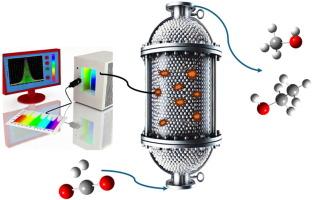探索异相二氧化碳加氢制甲醇和乙醇的催化剂发展:反应路径之旅
IF 13.1
1区 化学
Q1 Energy
引用次数: 0
摘要
由于化石燃料储量的不断减少以及二氧化碳排放量的增加导致全球变暖,人们对替代燃料生成技术的追求日益高涨。在提出的各种方法中,利用二氧化碳加氢生产甲醇和乙醇等适销对路的碳基产品是一种实用的方法,具有减少二氧化碳排放的巨大潜力。虽然目前已利用二氧化碳生产了大量甲醇,但开发高效稳定的催化剂对于进一步提高转化率和选择性,从而降低工艺成本至关重要。通过深入研究甲醇和乙醇生产反应途径的异同,可以发现推动 C-C 偶联的关键因素。找出这些因素有助于我们开发更有效的乙醇合成催化剂。在本文中,我们探讨了不同催化剂如何通过产生各种中间产物来启动甲醇或乙醇的合成。本文总结并介绍了通过光谱技术和理论计算(包括操作X射线方法、傅立叶变换红外分析和DFT计算)提出的催化机理。接下来的讨论探讨了影响 C-C 偶联和优化二氧化碳转化为乙醇的转化率的催化剂结构特性和组成。最后,本综述探讨了最近用于选择性甲醇和乙醇生产的催化剂,重点是单原子催化剂。本文章由计算机程序翻译,如有差异,请以英文原文为准。

Exploring catalyst developments in heterogeneous CO2 hydrogenation to methanol and ethanol: A journey through reaction pathways
The pursuit of alternative fuel generation technologies has gained momentum due to the diminishing reserves of fossil fuels and global warming from increased CO2 emission. Among the proposed methods, the hydrogenation of CO2 to produce marketable carbon-based products like methanol and ethanol is a practical approach that offers great potential to reduce CO2 emissions. Although significant volumes of methanol are currently produced from CO2, developing highly efficient and stable catalysts is crucial for further enhancing conversion and selectivity, thereby reducing process costs. An in-depth examination of the differences and similarities in the reaction pathways for methanol and ethanol production highlights the key factors that drive C–C coupling. Identifying these factors guides us toward developing more effective catalysts for ethanol synthesis. In this paper, we explore how different catalysts, through the production of various intermediates, can initiate the synthesis of methanol or ethanol. The catalytic mechanisms proposed by spectroscopic techniques and theoretical calculations, including operando X-ray methods, FTIR analysis, and DFT calculations, are summarized and presented. The following discussion explores the structural properties and composition of catalysts that influence C–C coupling and optimize the conversion rate of CO2 into ethanol. Lastly, the review examines recent catalysts employed for selective methanol and ethanol production, focusing on single-atom catalysts.
求助全文
通过发布文献求助,成功后即可免费获取论文全文。
去求助
来源期刊

Journal of Energy Chemistry
CHEMISTRY, APPLIED-CHEMISTRY, PHYSICAL
CiteScore
19.10
自引率
8.40%
发文量
3631
审稿时长
15 days
期刊介绍:
The Journal of Energy Chemistry, the official publication of Science Press and the Dalian Institute of Chemical Physics, Chinese Academy of Sciences, serves as a platform for reporting creative research and innovative applications in energy chemistry. It mainly reports on creative researches and innovative applications of chemical conversions of fossil energy, carbon dioxide, electrochemical energy and hydrogen energy, as well as the conversions of biomass and solar energy related with chemical issues to promote academic exchanges in the field of energy chemistry and to accelerate the exploration, research and development of energy science and technologies.
This journal focuses on original research papers covering various topics within energy chemistry worldwide, including:
Optimized utilization of fossil energy
Hydrogen energy
Conversion and storage of electrochemical energy
Capture, storage, and chemical conversion of carbon dioxide
Materials and nanotechnologies for energy conversion and storage
Chemistry in biomass conversion
Chemistry in the utilization of solar energy
 求助内容:
求助内容: 应助结果提醒方式:
应助结果提醒方式:


